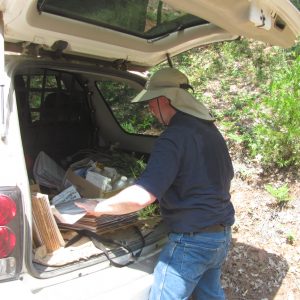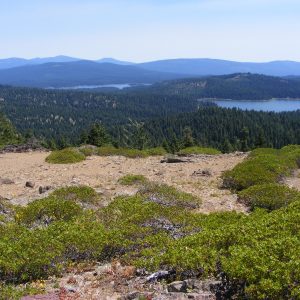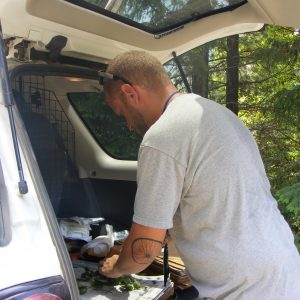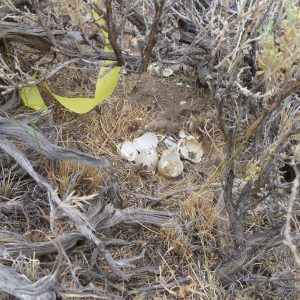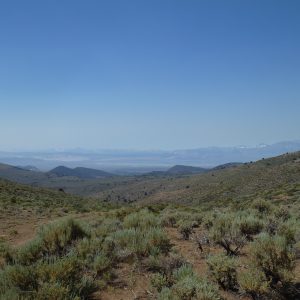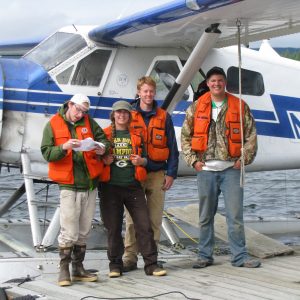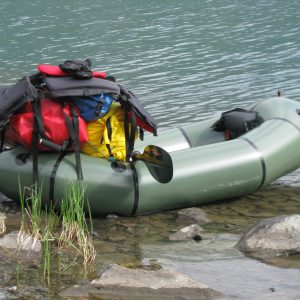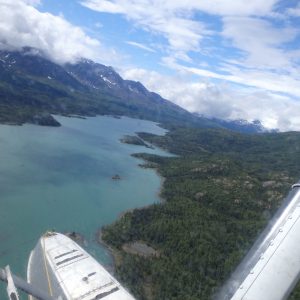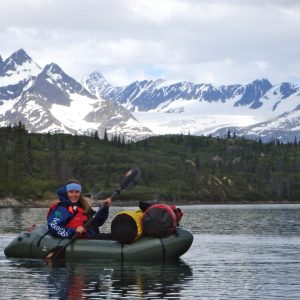
Monitoring on the Trout Creek Mountains
The Trout Creek Mountains are located in the southeastern section of the Burns BLM District. This area was well known for its plant diversity, beautiful landscape, and large populations of sage grouse. Last year, there was a massive fire known as the Holloway Fire. This fire burnt an enormous amount of land. Some of the areas within the Trout Creek Mountains recovered, but many areas needed to be drill seeded to help the land get re-established with native plants. This would hopefully prevent future cheat grass (Bromus tectorum) establishment.
Our job was to monitor a large amount of plots located everywhere on the Trout Creek Mountains. Our priority was to monitor the treated sites that have been drilled seeded. Most of the Trout Creek Mountains had a large amount of rain and the higher elevations could easily have over 20 species of plant in a monitoring site. Unfortunately, the lower elevations that were drilled seeded had trouble getting established due to the rough climate. I was amazed about the color of this region. You could literally see the colors of the rainbow when looking at all the species of forbs in the landscape.
White: Common Yarrow (Achillea millefolium) and Prickly Sandwort (Arenaria aculeata)
Pink: Oregon Checker Mallow (Sidalcea oregana)
Red and Orange: Wyoming Indian Paintbrush (Castilleja linariifolia)
Yellow: Western Groundsel (Senecio integerrimus), Modoc Hawksbeard (Crepis modocensis), and Desert Yellow Daisy (Erigeron linearis)
Green: Green Gentian (Frasera speciosa) ((My favorite ^_^))
Blue: Tall Meadow Larkspur (Delphinium burkei)
Indigo: Rocky Mountain Iris (Iris missouriensis)
Violet: Tailcup Lupine and Silvery Lupine (Lupinus caudatus/ Lupinus argenteus )

A field of Lupine with waddling Sage Grouse!
Despite the beauty of the landscape around us, we had to brace ourselves for the elements. Temperatures could get over 90-100 degrees easily, the horseflies were out in full swarm, and the topography was very steep. When I had to ride the four wheeler/ rhino around, we would be on a 45 degree angle on a cliff to get to our next destination. Also, you have to bring plenty of water and protection. We had bandannas to protect us from the dust that got in our eyes and mouth during the drive. If we did not have eye protection, we would have blood shot eyes due to the dry/dusty conditions. Beyond the elements, this has been an amazing opportunity! We got to see new plants, meet new people, and learn different techniques!
In the midst of the rough conditions, we got to stay at a government place known as the Hilton. This place is like a giant trailer that could sleep fifteen people. They have a coral in the back ,with mules and a nice bit of property with porphyritic rock volcanic rock indicating the violent geologic past this area had.
Sage Grouse All Over the Place
One of the creatures that blew us out of the water were the Sage Grouse (Centrocercus urophasianus)! We never seen them before now. In some of the areas, within the Trout Creek Mountains, there was a population of thirty or more. Every day, we would see these birds flying or waddling to their heart’s content. One morning I was driving to our next destination and thirty sage grouse flew into the air! I have never seen so many before!! One time, I saw many of them waddling along the roadside amongst the lupine and I took a lot of good pictures. They reminded me of quails with their waddling and ninja like hiding skills. Sage Grouse do remind me of the Chestnut Bellied Sandgrouse (Pterocles exustus) from Hawaii that were introduced, but the Sage Grouse were larger. One could easily find them amongst mature stands of Mountain Big Sagebrush (Artemisia tridentata ssp. vaseyana). We were fortunate to see these birds, unfortunately they are not common in the rest of our area.

Misadventures
Female Clones?
One day after work we were visited by two girls who were working for the natural resources division at the Oregon State University. They had a similar job to us, but they had to catalog all of the plants in the area, so they could map them later on. The funny part was that they were like our clones…but they were female! Same personality same hair color, and similar heights. We compared notes and talked about the different plants we had seen on the Trout Creek Mountains.
Scouting
One of my side jobs for monitoring was to scout out a location. Some sites were hidden or did not have road access to them. Sometimes I would walk over a mile and up a butte to find a plot. This was great exercise! Some plots I scouted out were gone or ceased to exist. The directions or the photos for some of the sites did not help us at all. One of the “photographs” was a drawn picture of the ground…which did not help out at all. A tip I learned was to look under the cow pies for the plot markers. Some scouting locations were surrounded by barb wire fencing, which I would limbo under. Haha! All in a day’s work! 😉
Horned Lizards
The Horned Lizards (Phrynosoma douglassi or Phrynosoma platyrhinos ) were one of my favorite animals of the Trout Creek Mountains! They were camouflaged and could flatten their body to avoid predators. I would catch them and they would just sit on my arm, while I went to monitor the next plot. They did not bite and were very fascinating to look at. They would give you a face that would either display “Hehehe… I am going to get you” or a “I am a rock and am non-existent.” When they flatten their body they would have saw like scales along their sides, which made them look like a horned Frisbee that could do some serious damage.

Horned Lizards!!
This was our first week monitoring at the Trout Creek Mountains. Next week will be just as exciting containing brilliantly colored forbs, ninja-like sage grouse, and beautiful topography! I can’t wait until then! ^_^
Have a great day!
Justin Chappelle
Burns/ Hines BLM Intern
Geographer, Bird watcher and Botanist
Fun Fact: Having a milkshake after a hard day of work would help you become 20% cooler in ten seconds flat….just saying…






